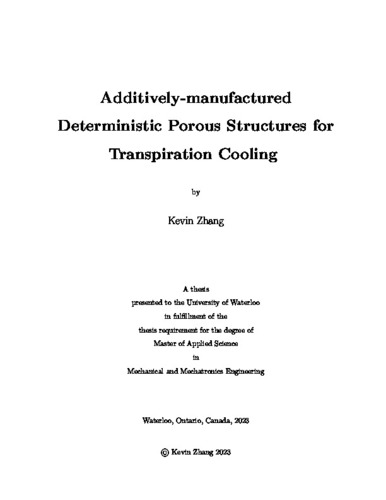| dc.contributor.author | Zhang, Kevin | |
| dc.date.accessioned | 2023-07-17 12:44:04 (GMT) | |
| dc.date.available | 2023-07-17 12:44:04 (GMT) | |
| dc.date.issued | 2023-07-17 | |
| dc.date.submitted | 2023-07-04 | |
| dc.identifier.uri | http://hdl.handle.net/10012/19611 | |
| dc.description.abstract | Transpiration cooling is increasingly being studied as a method of thermal protection in hypersonic flight, rocket engine liners, and gas turbines. To date, materials for transpiration cooling have been restricted to porous ceramic composites and sintered metal foams. Advances in additive manufacturing have enabled the creation of architected lattices, which have deterministic mesostructures. One such family of lattices are triply-periodic minimal surfaces (TPMS), which are continuous, analytically-defined, repeating 3D geometries. Additively-manufactured metal TPMS structures are already being studied for biomedical applications and it is proposed that they could offer several advantages for transpiration cooling as well: high surface area-to-volume ratio, pore inter-connectivity, and mechanical strength. In this thesis, the fluid flow behaviour through gyroid TPMS lattices is investigated through computational fluid dynamics simulation, using the lattice Boltzmann method (LBM). A comparison is made between ideal geometry and the as-printed geometry of samples fabricated with laser powder bed fusion and characterized using X-ray computed tomography. The results of this analysis are applied to manufacture and simulate two different leading edge structures using functionally graded TPMS in an attempt to produce non-uniform flow permeability in a more practical context. In all cases, permeability of the as-printed parts was lower than for their respective designs, due to the irregular surface morphology. Further complications were introduced by the presence of over- and underprinting. These results highlight the importance of considering performance deviation in actual manufactured parts. The outcomes of this research will assist in developing a methodology for the design optimization via performance simulation of these structures to meet fluid flow requirements for transpiration cooling applications. | en |
| dc.language.iso | en | en |
| dc.publisher | University of Waterloo | en |
| dc.subject | additive manufacturing | en |
| dc.subject | porous media | en |
| dc.subject | triply-periodic minimal surfaces | en |
| dc.subject | computational fluid dynamics | en |
| dc.title | Additively-manufactured Deterministic Porous Structures for Transpiration Cooling | en |
| dc.type | Master Thesis | en |
| dc.pending | false | |
| uws-etd.degree.department | Mechanical and Mechatronics Engineering | en |
| uws-etd.degree.discipline | Mechanical Engineering | en |
| uws-etd.degree.grantor | University of Waterloo | en |
| uws-etd.degree | Master of Applied Science | en |
| uws-etd.embargo.terms | 0 | en |
| uws.contributor.advisor | Hickey, Jean-Pierre | |
| uws.contributor.advisor | Vlasea, Mihaela | |
| uws.contributor.affiliation1 | Faculty of Engineering | en |
| uws.published.city | Waterloo | en |
| uws.published.country | Canada | en |
| uws.published.province | Ontario | en |
| uws.typeOfResource | Text | en |
| uws.peerReviewStatus | Unreviewed | en |
| uws.scholarLevel | Graduate | en |

